Yves GARY Hits: 4394
Category: 1895 : CHALLENGE N°9
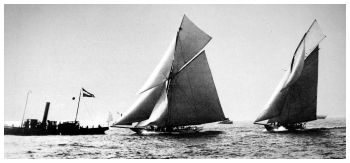 Won the Second Cup Race by 47 Seconds, after Fouling the Defender
Won the Second Cup Race by 47 Seconds, after Fouling the Defender Sept. 10, 1895 - The sea was as smooth as glass outside Sandy Hook, ...
Sept. 10, 1895 - The sea was as smooth as glass outside Sandy Hook, ...
... and the wind was light, and coming from the south, and every one who got out to see the second race between the Valkyrie and the Defender remarked that it was perfect Valkyrie weather.
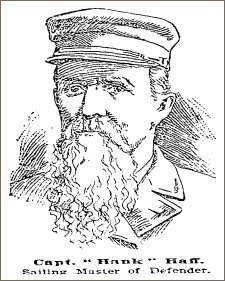
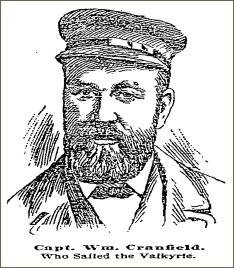 When Defender and Valkyrie came to the line for the second race in the series, on the morning of September 10th, the public had received no intimation of the shadow which had fallen on the sport. It was therefore with expectations of a fine race that a great crowd gathered to witness the second meeting of the yachts. Indeed there was every prospect of a good race that day. The weather was warm, though hazy, the incense of early autumn filling the air. There was a good sailing breeze from the south when the yachts came to the line.
When Defender and Valkyrie came to the line for the second race in the series, on the morning of September 10th, the public had received no intimation of the shadow which had fallen on the sport. It was therefore with expectations of a fine race that a great crowd gathered to witness the second meeting of the yachts. Indeed there was every prospect of a good race that day. The weather was warm, though hazy, the incense of early autumn filling the air. There was a good sailing breeze from the south when the yachts came to the line.
According to his custom, Lord Dunraven sailed on Valkyrie, and with him were his two daughters, Lady Rachel and Lady Eileen Wyndham-Quin. George L. Watson, Sailmaker Ratsey, of Cowes, Mr. Arthur Glennie, rear commodore of the Royal Portsmouth Yacht Club, (one of Lord Dunraven's chief advisers,) and Mr. H. Maitland Kersey, of New York, also sailed on the boat. The New York Yacht Club's representative on board was Mr. Joseph R. Busk.
On board Defender Lord Dunraven's representative was Mr. B. D. Henderson, a member of the Royal Yacht Squadron. Mr. C. Oliver Iselin was in charge of Defender, and Capt. Henry C. Haff was at the wheel. Capt. Sycamore, assistant to Capt. Cranfield, stood at Valkyrie's tiller.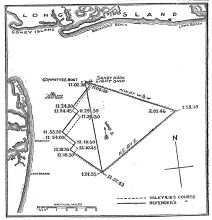
The course was set ten miles S. to windward, ten miles N. E. by E., and ten miles N. W. by W. 1/2 W., the first leg being to windward and the other two reaches. The wind was light, perhaps five miles an hour, when the boats came for the line in anticipation of the starting-gun. On the weather, or westerly end of the line, was the committee boat Luckenbach, at the leeward end the light-vessel.
The preparatory signal was given promptly at 10:50, the advertised time, and both yachts were then north of the line and both on the starboard tack. The Defender was more to the eastward, and directly after the gun was fired, she came about on the port tack, heading up toward the Valkyrie.
Valkyrie tacked, too, and, as the boats drew together, she was on the Defender’s windward quarter. Both yachts had their jibtopsails in stops, and, after holding on this tack for a short time, they wore round and headed to the northward again. They held this way for about two minutes, and then, jibing over, they hauled on the wind, and began to stand down for the mark.
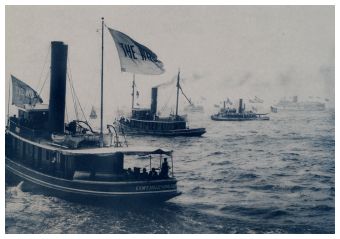 Then the steamship Yorktown, with a crowd of excursionists on board, for some reason or other steamed in between the two yachts. After the Yorktown had got out of the way both yachts were heading toward the committee boat, or westward end of the line, on the starboard tack. The Valkyrie was in the lead and to windward of the Defender. Capt. Sycamore had the tiller, while on the American boat Capt. Haff was at the wheel.
Then the steamship Yorktown, with a crowd of excursionists on board, for some reason or other steamed in between the two yachts. After the Yorktown had got out of the way both yachts were heading toward the committee boat, or westward end of the line, on the starboard tack. The Valkyrie was in the lead and to windward of the Defender. Capt. Sycamore had the tiller, while on the American boat Capt. Haff was at the wheel.
Both Captains were watching each other and watching their own boats. They were ready to take any opportunity that offered them to get the better position at the start. So far the honors were with the Valkyrie. As they approached the line Capt. Sycamore bore somewhat off his course, and then luffed up sharply again, evidently with the intention of spoiling the Defender’s wind.
Capt. Haff held the Defender straight for the line, and as the Valkyrie came up in the wind again her big steel boom swung out and caught in the starboard topmast shroud of the Defender, pulling it out of the spreader. For a moment it looked as though the topmast would be carried out of the American boat.
 Defender’s Topmast Buckles.
Defender’s Topmast Buckles.The stick buckled under the weight of the clubtopsail and the jibtopsail, but in an instant Capt. Haff threw over his wheel, the yacht spun around on the port tack, and, the strain being taken off the disabled shrouds, the stick was saved. Then the Deer Island sailors had to do some lively work.
The jibtopsail was taken in, two men were sent up on the spreader, and while the starboard shroud was slack they lashed it out on the end of the starboard spreader and made it as firm as they possibly could. In the meantime the Valkyrie had shot across the line well down toward the western end. She was on the starboard tack and was footing fast. They had to make quick time on the Defender in order to avoid being handicapped. The starting gun had been fired, and but for the mishap they would have been across the line right in the stern of the Valkyrie, and the two boats would have been having it nip and tuck for the windward work.
The damage was quickly repaired so far as possible, and while the two men were still on the spreader trying to complete their work, the Defender was put about again, and she headed for the line on the same tack as the Valkyrie. The times taken as the two yachts crossed the line were: Valkyrie 11:00:13, Defender 11:01:15. The Defender had lost a minute at the start. The minute would not count against her, because she had two minutes in which to cross the line, but she had lost a good position for if the mishap had not happened she would have been but a few seconds worse off than the Valkyrie, whereas she was now considerably to the leeward of the English boat.
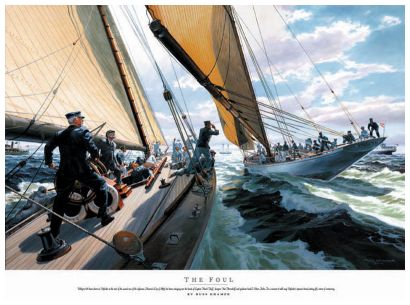 On the Valkyrie they were making the most of the advantage they had thus far gained. The men were all lying up to windward as flat on deck as it was possible for them to get. Capt. Sycamore, at the tiller, was crouching down to leeward of the big stick, and he was glancing first up at the headsails and then casting an eye to the leeward to see the Defender.
On the Valkyrie they were making the most of the advantage they had thus far gained. The men were all lying up to windward as flat on deck as it was possible for them to get. Capt. Sycamore, at the tiller, was crouching down to leeward of the big stick, and he was glancing first up at the headsails and then casting an eye to the leeward to see the Defender.
On the Defender nearly all the crew were in their proper positions. Hank Haff was kneeling down in his old position to leeward of the wheel, C. Oliver Iselin was tending his jib sheet, Mrs. Iselin was in her old position in the companionway, with her head just above deck, and Mate Miller and two seamen were trying to fix up the damage done and make the shroud as strong as they possibly could. A sea-man went forward and hoisted the red flag standing for the letter "B" in the starboard rigging. This was the signal that the Defender protested, and those on the committee boat signaled back that the protest was noted.
This first tack was a very short one, and thirty seconds after the handicap gun had been fired the Defender tacked to port. The Valkyrie spun round five seconds later, and the two yachts were then heading west-southwest in toward the Highlands. Capt. Haff probably tacked so quickly in order that the men on the spreader might be able to work easily without there being any strain on the shroud. The Valkyrie, in the meantime, was holding on her course and pointing high and quickly widening the gap between the two yachts.
 The Defender was without her jibtopsail, and it was a day that jibtopsails counted for a good deal. The Valkyrie's jib topsail was drawing beautifully. Capt. Haff gave the Defender a rapful, intending to romp her off and out-foot the Englishman with the idea of possibly making up what he had lost to windward. They held on this port tack until they had passed the Scotland Lightship, and then, at 11:24:30, the Defender tacked to starboard and was followed fifteen seconds later by the English boat.
The Defender was without her jibtopsail, and it was a day that jibtopsails counted for a good deal. The Valkyrie's jib topsail was drawing beautifully. Capt. Haff gave the Defender a rapful, intending to romp her off and out-foot the Englishman with the idea of possibly making up what he had lost to windward. They held on this port tack until they had passed the Scotland Lightship, and then, at 11:24:30, the Defender tacked to starboard and was followed fifteen seconds later by the English boat.
Valkyrie Considerably Ahead.
It was seen then that the Valkyrie was considerably ahead and about 300 yards to windward of the Defender, and the Defender was in a mighty bad place. Her wind was being broken and every minute she was getting further and further away from the English boat. The outlook wag anything but bright, but those who were watching the race consoled themselves by saying that but for the accident things would be different.
 Valkyrie was doing remarkably well, and she was proving that in the weather for which she is supposed to have been built she is a very slippery craft. She was footing fast, pointing high, and going through the water leaving very little fuss, and making very little wave forward. The Defender was going along in the old style for which she has become famous, but in her crippled condition she was unable to cope fairly with the Englishman. This tack off shore lasted for just five minutes, and then both spun round on the port tack, heading again in toward the shore. The damage had been repaired as far as possible on the Defender. A big bunch of rope on the end of the spreader marked where the shroud was lashed to the spar. But lash it as firmly as they could it was nothing like as taut as when it was passed through the hole and held in place by the bolts.
Valkyrie was doing remarkably well, and she was proving that in the weather for which she is supposed to have been built she is a very slippery craft. She was footing fast, pointing high, and going through the water leaving very little fuss, and making very little wave forward. The Defender was going along in the old style for which she has become famous, but in her crippled condition she was unable to cope fairly with the Englishman. This tack off shore lasted for just five minutes, and then both spun round on the port tack, heading again in toward the shore. The damage had been repaired as far as possible on the Defender. A big bunch of rope on the end of the spreader marked where the shroud was lashed to the spar. But lash it as firmly as they could it was nothing like as taut as when it was passed through the hole and held in place by the bolts.
As soon as they had got well away on this tack, one of the Deer Island sailors went out on the end of the bowsprit, and everybody watched to see what was going to happen next. Then another followed, and another, until there were six men out there, and they were seen passing out a sail. “They are going to set a jibtopsail," shouted a Defender enthusiast. ”now we'll see how she'll beat the Englishman." The sail was passed out quickly, run up the stay, and at 11:33:15, a No. 2. jibtopsail was broken out. The men got back into their positions, and for a short time it looked as though all was well, but after carrying the sail just two minutes, the men went out again, and the sail was taken in. The strain was too much for the mast in its weakened condition. Men went up on the spreader again, and more lashing was done. This constant moving about on board the Defender was a serious handicap to the boat, as it upset the trim of the craft, and she was not steady, and then the shrouds not being as taut as they ought to have been, it was impossible to got the club topsail perfectly flat, and that was not drawing as well as it might.
The sail was passed out quickly, run up the stay, and at 11:33:15, a No. 2. jibtopsail was broken out. The men got back into their positions, and for a short time it looked as though all was well, but after carrying the sail just two minutes, the men went out again, and the sail was taken in. The strain was too much for the mast in its weakened condition. Men went up on the spreader again, and more lashing was done. This constant moving about on board the Defender was a serious handicap to the boat, as it upset the trim of the craft, and she was not steady, and then the shrouds not being as taut as they ought to have been, it was impossible to got the club topsail perfectly flat, and that was not drawing as well as it might.
Taking all these thing into consideration, the Defender was sailing a wonderful race, and some who saw her good performance when reaching last Saturday remembered that the second and third legs of the course yesterday were both reaches, and they thought it quite possible that the American boat would make up then what she lost to windward.
Capt. Haff kept on giving the Defender a good rap full, and she footed as fast as the Valkyrie, but was sagging down to leeward. It was the only thing for him to do under the conditions. The wind was freshening, and some yachtsmen hoped it would freshen so that the Valkyrie would have to take in her jibtopsail, or that the two yachts would have to take in their clubtopsails, and then they would be on even terms.
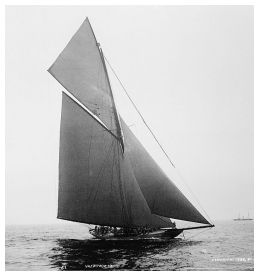 At 11:53:50 the Defender tacked to starboard, and the Valkyrie followed just ten seconds later. The Valkyrie was then a third of a mile in the lead, and she quickly increased this to half a mile at noon. They held on this tack for just seventeen minutes, and at 12:10:30 Capt. Haff threw the wheel on the American yacht over and brought her about on the port tack. She was heading then toward the Jersey coast again.
At 11:53:50 the Defender tacked to starboard, and the Valkyrie followed just ten seconds later. The Valkyrie was then a third of a mile in the lead, and she quickly increased this to half a mile at noon. They held on this tack for just seventeen minutes, and at 12:10:30 Capt. Haff threw the wheel on the American yacht over and brought her about on the port tack. She was heading then toward the Jersey coast again.
The Valkyrie followed the Defender just fifteen seconds later, Capt. Cranfield evidently intending to keep right on the American boat's weather as long as he possibly could. The wind was holding true. It was just what the Englishmen had been asking for, and it was getting stronger and stronger every minute. It was still a light breeze, though, but the yachts were misting wonderful speed under the conditions.
The port tack was a short one, and at 12:_18:30 the Valkyrie tacked to starboard, being followed five seconds later by the American boat. The Defender was then right in the Valkyrie’s wake, but was at least half a mile behind. Both were then on the starboard tack, standing out to sea. Two thirds of the distance to the first mark had now been covered, and the Defender was not being beaten nearly as badly as many had expected she would be, 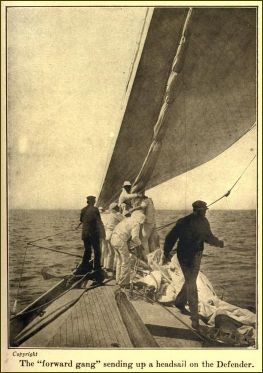 and, allowing for her crippled condition, it was generally conceded that in light weather the two boats are wonderfully close when going to windward, and that the boat that gets the weather position at the start will probably hold it to the end it the wind holds true.
and, allowing for her crippled condition, it was generally conceded that in light weather the two boats are wonderfully close when going to windward, and that the boat that gets the weather position at the start will probably hold it to the end it the wind holds true.
The wind by this time was blowing about ten-knots an hour, and under the freshening breeze both yachts began to heel a little, the Valkyrie appearing to be a little more tender than the Defender, but this could be caused by the extra sail which the Valkyrie was carrying.
The fleet of excursion steamers gave the yachts a good show. They kept well astern of them, and there was no cause for complaint from either boat. The fleet of patrol boats headed the procession following the two racers, and kept the course clear as the yachts went off on the different tacks.
By 12:30 the stake boat was in sight. The Valkyrie was then being driven for all she was worth, and every stitch of canvas was pulling for all it was worth. Little flecks of white foam made their appearance on top of the tiny waves, and down in the southward where the yachts were going to there was every indication of the wind being much fresher. The Valkyrie made much more fuss in the water than she did at the start. The water boiled up under her bow, and on her lee side that big wave began to make its appearance, and behind her she left a long, foamy wake. She was going fast too, and was heading straight for the stake. About half a mile astern of her the Defender was flying after her.
 A stern chase at any time is a long chase, and an unpleasant one, too, but under crippled conditions like those of the Defender yesterday it must be exceedingly unpleasant to see the leading boat gradually getting further and further away.
A stern chase at any time is a long chase, and an unpleasant one, too, but under crippled conditions like those of the Defender yesterday it must be exceedingly unpleasant to see the leading boat gradually getting further and further away.
As they drew near the outer mark both yachts began to pinch in order to fetch. Capt. Cranfield kept on jamming his yacht out to windward, and Capt. Haff, too, was taking advantage of every little puff to shoot the Defender up as far as possible in the same direction. It looked at first as though neither boat would fetch but by a series of luffs and continued pinching both were able to do so without making another tack.
The time taken as they rounded the first mark at the end of the ten miles beat to windward were as follows: Valkyrie, 12:57:48, Defender, 1:01:35.
The Valkyrie rounded the mark 3 minutes and 52 seconds ahead of the Defender. It had taken the Valkyrie 1 hour 51 minutes and 30 seconds to beat the ten miles. It had taken the Defender 2 hours and 20 seconds, so that on, actual sailing the Valkyrie had beaten the Defender two minutes and fifty seconds.
The second leg was to the northeast by east. The Wind still from the south was over the starboard quarter. The Valkyrie eased her boom off as she rounded, took in her small jib topsail, and sent the balloon up in stop. It was broken out just four minutes after she passed the stake—a very smart piece of work.
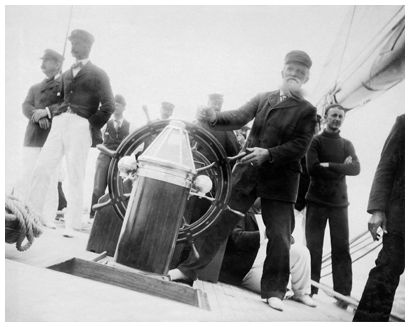 The Defender began to send a baby jibtopsail in stops before she rounded the mark, and after she rounded broke it out. There were a groan heard on all sides as this small sail appeared. Everyone had expected a balloon, but as the yachts were still on the starboard tack, and it was the starboard spreader that had broken, to have put a big balloon jibtopsail would probably have carried away the topmast.
The Defender began to send a baby jibtopsail in stops before she rounded the mark, and after she rounded broke it out. There were a groan heard on all sides as this small sail appeared. Everyone had expected a balloon, but as the yachts were still on the starboard tack, and it was the starboard spreader that had broken, to have put a big balloon jibtopsail would probably have carried away the topmast.
One old skipper, as he watched the sail come out, remarked: “I'd have set the balloon and taken the risk. If the stick stood then she'd overhaul the Valkyrie. If the stick broke, then she'd be in no worse position than she is now."
The staysail was taken in on the Defender and a balloon staysail set in its place. The staysail and jib were both taken in on the Valkyrie, and then both yachts were speeding toward the second mark at the rate of ten knots an hour. The Valkyrie seemed to draw ahead. It was only natural that she should. Her immense balloon jibtopsail was drawing beautifully. It was not sheeted home as flat as it was last Saturday, and they seemed to have taken a wrinkle or two from the Americans on the way to handle this big piece of canvas.
The Valkyrie as she went through the water made more fuss than she had during any part of the day. She dragged a great big wave along behind her, and this wave must have seriously retarded her progress. She threw considerable water with her bow and lots of it fell on the deck forward. The Valkyrie seemed to be heading off her course a little. This was probably due to the pressure of wind in her balloon, while the Defender was sailing straight for the mark, and at one time it looked as though she would get so tar to windward of the Valkyrie as to break the Englishman's wind.
 The Yachts made rattling good time on this leg, and by 1:45 the second mark was plainly in sight. Five minutes later the balloon on the Valkyrie was taken in, and a No. 2 jibtopsail set up in its place. It took four minutes to change these sails, and the Defender was able to close up considerable of the gap between the two boats. The Valkyrie's sheet was trimmed in a little and she hauled on the wind in order to weather the second mark.
The Yachts made rattling good time on this leg, and by 1:45 the second mark was plainly in sight. Five minutes later the balloon on the Valkyrie was taken in, and a No. 2 jibtopsail set up in its place. It took four minutes to change these sails, and the Defender was able to close up considerable of the gap between the two boats. The Valkyrie's sheet was trimmed in a little and she hauled on the wind in order to weather the second mark.
The times taken as the two yachts jibed were as follows: Valkyrie, 1:58:10, Defender, 2:01:45.
The elapsed times for the ten miles’ reach were: Defender, 1 hour 10 second; Valkyrie, 1 hour 27 seconds. So that the Defender had gained seventeen seconds on the broad reach.
Ten miles an hour in such light winds as prevailed yesterday is remarkably fast traveling, and showed conclusively that these two yachts are the fastest that have ever raced in these waters—probably the fastest that have ever raced in the world.
Capt. Haff made up his mind to make a desperate effort to win on the last leg. The Valkyrie made a beautiful jibe around the mark. Her head sails were quickly trimmed down, and, with her main sheet trimmed in and close hauled, she headed for the lightship. The course was northwest by west one-half west.
The Defender took in her small jib topsail before jibing and then trimmed in her sheet in order to prevent any further mishaps. A No. 2 jibtopsail was sent up in stops. The last reach was on the port tack, and Capt. Haff had made up his mind to drive the Defender for all she was worth. After rounding the mark the jibtopsail was broken out and sheeted down flat. The mainsheet was trimmed in and the Defender seemed to jump forward at once. Men were sent out on the bowsprits on each yacht to clear away the sails that had been taken in, and then the crews all got back to their positions on deck.  Could the Defender gain enough in ten miles to get the victory? She was 2 minutes and 35 seconds behind the English boat at the second mark. Twenty-nine seconds were allowed her, so that she had to make up 2 minutes and 5 seconds to tie the Englishman's time.
Could the Defender gain enough in ten miles to get the victory? She was 2 minutes and 35 seconds behind the English boat at the second mark. Twenty-nine seconds were allowed her, so that she had to make up 2 minutes and 5 seconds to tie the Englishman's time.
The Valkyrie was sailing like a witch. She heeled gracefully in the water and fairly flew on toward the outer mark. It seemed impossible to make up the time wanted in the short distance of ten miles with the English boat traveling as she was, but the Defender was making a desperate effort, and she was reaching as she had never reached before under those conditions.
Slowly but surely she began to cut down the space between the two boats. The excursion steamers gave her wide berth, in order that she might have the benefit of every ounce of wind that she could get. They were hurrying on toward the mark as fast as they could go, and if the Defender could get near enough to win, she would get a rousing welcome. The yachts were traveling so fast that some of the tugs and steamers were being left behind, while others, and boats that are reputed to be fast, too, were doing their utmost to keep ahead.
The lightship gradually loomed up in the distance, and it seemed altogether too near to those who wanted the Defender to win. To the Englishmen and to the admirers of the Valkyrie it still seemed to be miles away, and, as they looked ahead and then looked behind to see the American boat coming, they began to think that the race was lost after all. The committee boat steamed on and anchored in position to take the finishing time, and the steamers congregated around the line, everybody wondering which boat would win. The excitement was intense, and it was anybody s race.
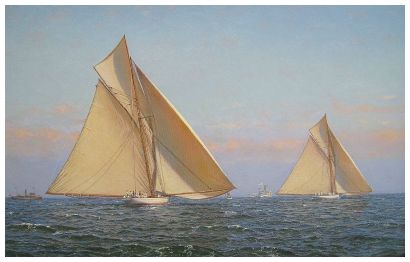 On came the Valkyrie, speeding toward the mark as fast as she could be driven by Capt. Cranfield, and behind her, rapidly closing up the gap, was the Defender, being driven as fast as it was possible to drive her by Capt. Haff.
On came the Valkyrie, speeding toward the mark as fast as she could be driven by Capt. Cranfield, and behind her, rapidly closing up the gap, was the Defender, being driven as fast as it was possible to drive her by Capt. Haff.
Lord Dunraven and his friends on the Valkyrie were watching ahead for the lightship, and then they cast furtive glances be-hind to see how near the American yacht was getting to them. On the American boat Mr. Iselin was watching ahead, first looking at the Valkyrie and gauging how they were running up on her, and then glancing further on toward the lightship, evidently wishing it was a mile or two further away.
If the Defender could win the race it would be a great achievement, after the way she was handicapped at the start, and everybody on board realizing this was doing his best to succeed. The water was just boiling under the two yachts’ bows, and it was piling along the lee rail of the Defender more than it had at any time during the race. The crews on both boats were flattening themselves on the decks as they never flattened themselves before.
It was only a half a mile to the lightship, and the Defender had already closed up about half the distance there was between the two atthe outer mark. The Valkyrie kept on and on and passed through the lane of vessels that had congregated at the finish, and at 2:55:22 she shot across the line and was greeted by a tooting or whistles that is always given to the first yacht home. After crossing the line she came up in the wind and those on board watched to see the Defender coming along.
 Everybody had his watch out, and everybody began to count off the seconds after the Valkyrie had crossed. The difference between the two yachts at the start, 1 minute and 2 seconds, soon went and the yacht was fast approaching the finish. It seemed for awhile as though the allowance would cut an important factor in the race, but that, too, soon disappeared, and the Defender had not crossed the line. She was a beaten boat, and she crossed at 2:57:40, just 2 minutes and 12 seconds behind the Valkyrie. The last ten miles reach had been made by the Defender in 0:55:55. The Valkyrie’s time was 0:57:12, so that the Defender had beaten the Valkyrie by 1 minute and 17 seconds.
Everybody had his watch out, and everybody began to count off the seconds after the Valkyrie had crossed. The difference between the two yachts at the start, 1 minute and 2 seconds, soon went and the yacht was fast approaching the finish. It seemed for awhile as though the allowance would cut an important factor in the race, but that, too, soon disappeared, and the Defender had not crossed the line. She was a beaten boat, and she crossed at 2:57:40, just 2 minutes and 12 seconds behind the Valkyrie. The last ten miles reach had been made by the Defender in 0:55:55. The Valkyrie’s time was 0:57:12, so that the Defender had beaten the Valkyrie by 1 minute and 17 seconds.
On elapsed time the Valkyrie had beaten the Defender 1 minute and 16 seconds. On corrected time the Valkyrie beat the Defender 47 seconds.
The Defender was greeted as if she were a winner. Guns were fired, whistles were tooted, and cheers were given for the American boat, and their all the excursion steamers crowded around the committee boat in order to see the official time, many hoping that a mistake had been made.
The two yachts proceeded up the harbor under their own sails. The City of Bridgeport, the Valkyrie’s tender, followed along behind her, towing along W. G. Brokaw’s schooner Amorita. Several members of the Amorita crew are on board the Valkyrie.
The Bridgeport was kept busy all the way up the bay answering the salutes given to the Englishmen by the excursion steamers, and then these steamers would run alongside the Defender and cheer the American boat and crew. Mrs. Iselin waved her handkerchief in answer to the salutes, and the members of the crew cheered back. The yachts sailed up to Bay Ridge and anchored there for the night.
